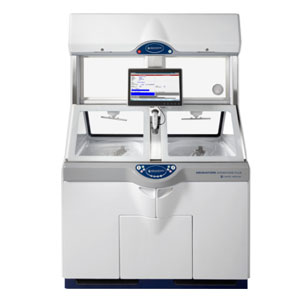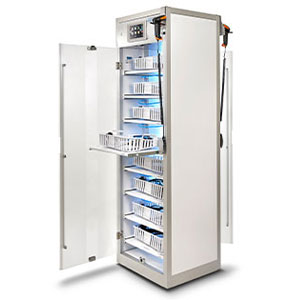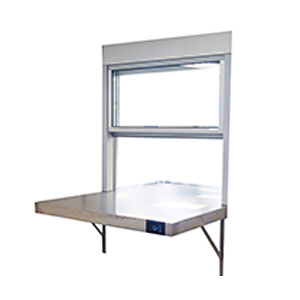Knowledge Center
April 20, 2023
Endoscopy Reprocessing Standards are Evolving
ST91 & AORN Recommend Unidirectional Workflow for Reprocessing Endoscopes
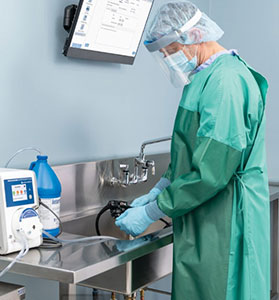 Endoscopy procedures are some of the fastest-growing medical procedures in the world. More than 250 million endoscopies are performed each year globally, with this number continuing to grow year over year1. With that, standards and regulations are constantly evolving to keep patients healthy and safe. How can hospitals and Ambulatory Surgery Centers (ASCs) safely reprocess devices and meet the demand for endoscopy procedures?
Endoscopy procedures are some of the fastest-growing medical procedures in the world. More than 250 million endoscopies are performed each year globally, with this number continuing to grow year over year1. With that, standards and regulations are constantly evolving to keep patients healthy and safe. How can hospitals and Ambulatory Surgery Centers (ASCs) safely reprocess devices and meet the demand for endoscopy procedures?
The place to start is by following the same best practices used for surgical device processing in Sterile Processing Departments (SPDs) and combining this with industry standards and guidelines for endoscopes specifically. Both AORN Guidelines for Processing Flexible Endoscopes, and ANSI/AAMI ST91 Comprehensive guide to flexible and semi-rigid endoscope processing in health care facilities, recommend unidirectional and two-room pass-thru designs, as typically seen in an SPD, be used for endoscope processing. Both standards/guidelines state this can ideally be accomplished using an automated endoscope reprocessor (AER) with pass-thru capabilities built into a wall, the use of a pass-thru window, or even a wall with a door to accomplish physical separation of the dirty and clean areas.
What Does Unidirectional or Pass-Thru Workflow Mean in Endoscope Processing?
Once an endoscope is processed, it is important to prevent cross-contamination, sometimes thought of as recontamination after disinfection. Two recommended methods exist to accomplish this: Unidirectional Workflow and Pass-Thru Workflow.
Unidirectional workflow is the process of ensuring the consistent one-way movement of endoscopes. Picture entering through one door and going from cleaning at the sink on the left to High-Level Disinfection (HLD) in the middle, then exiting through a separate door on the right.
Pass-Thru Workflow, however, creates a physical separation between the “clean” and “dirty” sides. Think about the design of a hospital SPD: These departments typically have a few separate rooms, often broken up into clean and dirty sides separated by physical walls.
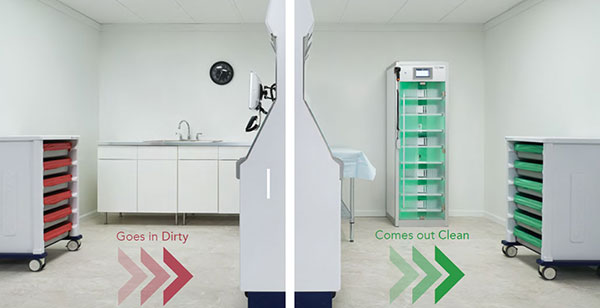
This best practice standard is used for all surgical devices, including non-critical and critical devices. Why has this multi-room setup been used in sterile processing? Equipment, technicians, and the work performed are separated, as is the level of PPE (Personal Protection Equipment) required for technicians. Using a pass-thru workflow is a way to reduce cross-contamination.
What are the Requirements for Endoscope Reprocessing?
The ANSI / AAMI ST91 standard released in 2021 has been put in place to ensure processes are improved, and patient and employee safety is the top priority. Often, very few endoscopes are reprocessed using this “dirty-side, clean-side” process. Endoscopes processed in smaller out-patient facilities are done in smaller spaces that may not have physical separation (such as a wall) between manual cleaning steps and HLD or liquid chemical sterilization. In these cases, a strict unidirectional workflow should be followed.
Without the physical separation between the dirty and clean sides, the risk of transferring microorganisms back onto devices is higher. The standards are evolving to reduce this risk and continually improve patient safety.
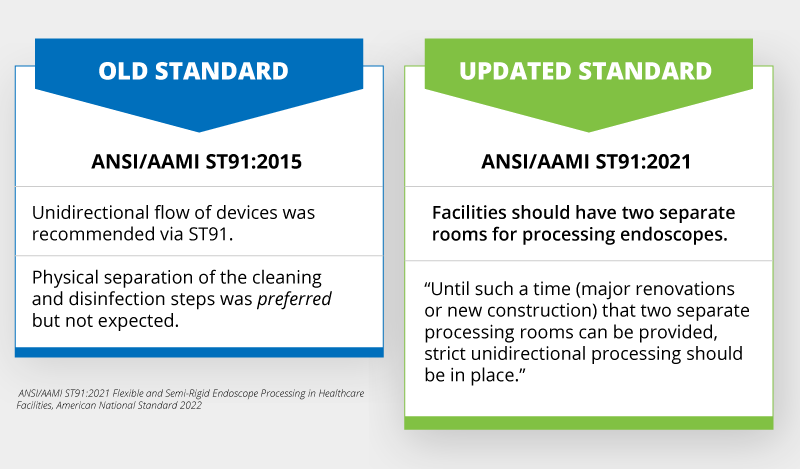
Having a defined space for disinfection/sterilization separate from manual cleaning is ideal. This design helps ensure the highest level of infection prevention plus patient and employee safety and is already broadly accepted in Europe. In the United Kingdom (UK), for example, HTM 01-06, Management and decontamination of flexible endoscopes, states that: “Endoscope reprocessing units should have in place the medical devices quality management system BS EN ISO 13485. This may be addressed by the use of double-ended endoscope washer-disinfectors with separate clean and dirty rooms (two-room option).”4
This standard is a requirement in the UK but is also widely adopted by other European countries.
What is the Best Practice for Unidirectional Workflow in Endoscope Reprocessing?
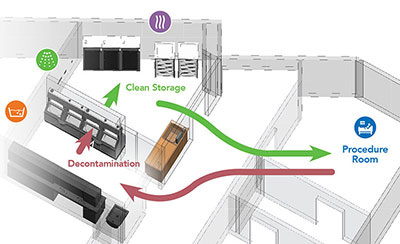
- After point-of-use processing is completed in the procedure room, devices should be transported safely to the decontamination area.
- Leak testing is conducted in this dedicated space, followed by manual cleaning and inspection.
- In a pass-thru workflow environment using an automated endoscope reprocessor (AER), the devices would enter on the dirty side and be removed on the clean side after a successful cycle. A pass-thru window, or even a door, could also be used to support a pass-thru workflow.
- Once the cycle is completed, the device will be received in a separate room to be dried and stored.
How to Plan for Unidirectional, Pass-Thru Workflow Renovations
Ideally, the manual cleaning space should be physically separated by walls or partitions in a two-room layout, as shown above. However, the updated ST91 standard also states: “Until such time (major renovations or new construction) that two separate processing rooms can be provided, strict unidirectional processing procedures should be in place to reduce risks of cross-contamination.” 3
While most facilities cannot accomplish major renovations or new construction right away, you should begin planning for this today.
It is also recommended that flexible endoscopes be stored in a clean and secure location outside the endoscopy procedure room to minimize the risk of cross-contamination during storage.
“In preparation of renovations, the work area design should allow adequate space for all functions and promote efficiency by minimizing distances between related areas. A pass-through window at counter height between the decontamination area and the clean processing area is recommended.” 3
When planning for the future, consider your facility’s current and anticipated patient volume and the quantity and types of endoscopes and processing equipment. The needs of your facility should determine the size of the processing areas.
Unidirectional flow is yet another way to avoid recontamination and protect the integrity of your hospital. Stay updated with endoscope reprocessing standards by using STERIS products that support unidirectional or pass-thru workflow.
Explore STERIS Products that Support Unidirectional Flow:
Article References
1 A Surprising Over 250 million Endoscopies Are Performed Each Year Globally, September 2022 - https://www.strategicmarketresearch.com/blogs/endoscopies-performed-each-year
2, 3 ANSI/AAMI ST91:2021 Flexible and Semi-Rigid Endoscope Processing in Healthcare Facilities, American National Standard 2022
4 HTM 01-06, Management and decontamination of flexible endoscopes, Part B: Design and installation
The Guideline for Processing Flexible Endoscopes, September 2022, AORN

